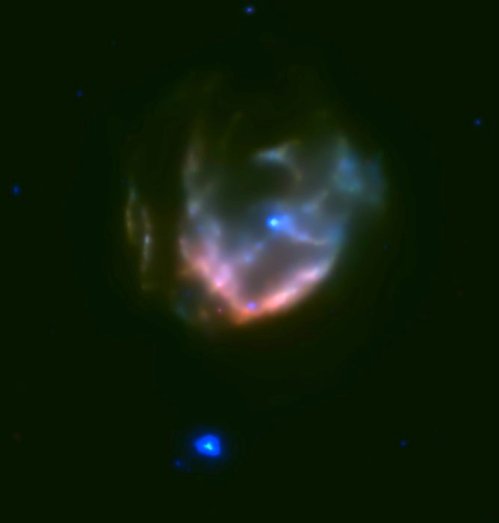
(Photo Credit: ESA/XMM-Newton/Ping Zhou/Nanjing University)
The European Space Agency’s XMM-Newton X-ray telescope has detected two very different neutron stars in the leftover remnants from a supernova explosion located about 23,000 light-years away. The telescope even discovered that one of the neutron stars, the smaller blue object in this lower half of this image, is actually a magnetar: a neutron star boasting an extremely strong magnetic field.
Massive stars end their lives with a bang, exploding as supernovas that release massive amounts of energy and matter into space. What remains of the star is a small and extremely dense remnant known as a neutron star or a black hole.
Neutron stars vary depending on their ages, the strength of their magnetic fields concealed beneath their surfaces, and the presence of nearby stars.
This image shows two very different neutron stars that were observed in the same patch of the sky with XMM-Newton. Energetic processes, taking place around neutron stars, can be explored with X-ray telescopes, like the XMM-Newton.
The green and pink bubble dominating the image is known as Kesteven 79, the remnant of a supernova explosion that is about 23,000 light-years away.
Astronomers estimate that Kesteven 79 is between 5000 and 7000 years old. Taking account of the time needed for the light to travel to Earth, the supernova that created K-79 must have exploded almost 30,000 years ago, leaving behind a young neutron star with a weak magnetic field, which can be seen as the blue spot at the centre of Kesteven 79.
However, the blue splotch below K-79 is an entirely different cosmic object: a neutron star boasting an extremely strong magnetic field, otherwise known as a magnetar.
Astronomers discovered this magnetar, named 3XMM J185246.6+003317, in 2013 after sifting through images taken in 2008 and 2009. After the discovery, they analysed previous photographs of the same patch of the sky, taken before 2008, but did not find any trace of the magnetar. This suggests that the detection corresponded to an outburst of X-rays released by the magnetar, likely caused by a dramatic change in the structure of its magnetic field.
While the neutron star in the supernova remnant is relatively young, the magnetar is likely a million years old; the age difference means that it is very unlikely that the magnetar arose from the explosion that created Kesteven 79, but must have formed much earlier.